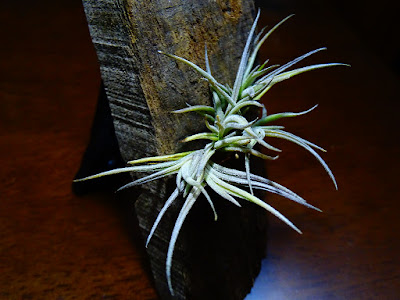Tillandsia bandensis is native to Bolivia, Paraguay, Uruguay, Argentina. It grow epiphyte in dry woods, at elevation of 300-2000 meters above sea level.
Tillandsia bandensis, also called as Tillandsia bandensis var. intermedia, Tillandsia pilosa, Tillandsia recurvata var. majuscula, is a species of the genus Tillandsia. This species was described by John Gilbert Baker in 1887.
IDENTIFY TILLANDSIA BANDENSIS AIR PLANT
Tillandsia bandensis is native to Bolivia, Paraguay, Uruguay, Argentina. It grow epiphyte on trees and rocks in dry woods, at elevation of 300-2000 meters above sea level.
It is an epiphytic, caulescent, 10-20 cm long with stem much branched with the branching largely in a single plane, 4-6 cm long that have densely distichous, 5-7 cm long, densely pruinose- or tomentose-lepidote, cinereous to fuscous leaves.
This air plant blooms from simple and distichous-flowered, linear-lanceolate, 2-3 cm long, 3-5 mm wide, 2-4-flowered inflorescence. Floral bracts not at all imbricate, equaling or slightly longer than the internodes, ovate-elliptic, acute, more or less nerved, 9-12 mm long, the lower ones equaling or somewhat shorter than the sepals and sometimes sparsely lepidote, the upper ones much shorter than the sepals and glabrous. The flowers are erect, appressed to the rhachis; pedicels very short, obconic. Sepals subelliptic, acute, 8-10 mm long, 2.5-3 mm wide, thin, nerved, glabrous, equally subfree. Petals 15-16 mm long, claw narrow, blade broadly elliptic or obovate, 5 mm long, 6 mm wide, blue or violet.
TILLANDSIA BANDENSIS AIR PLANT CARE AND CULTURE
Cultural information should only be used as a guide, and should be to be adapted to suit you. Your physical location; where you grow your plants, how much time you have to devote to their care, and many other factors, will need to be taken into account. Only then can you decide on the cultural methods that best suit you and your plants.
Light:
Tillandsia bandensis does well indoors but likes bright, indirect light. Keep this plant away from direct sunlight as this will cause the plant to develop burn marks.
Temperature:
The ideal temperature is range from 10°C to 30°C. Get it early enough in the fall if you grow it outside, so that it does not face night temperatures below 4 or 5 ° C, especially if it is wet. The plants can faced temperatures close to 0 ° C (sheltered and dry) for a few hours without damage.
Humidity:
This species need the humidity level of moderate to high. Good aeration is required, the plant must dry quickly (in less than an hour).
Substrate, growing media and repotting:
Tillandsia bandensis refer to be mounted on a solid substrate that does not retain water. You can glue the plant directly to the surface with a strong adhesive, or you can wire the plant to the base. Don't cover the base of the plant with moss or it may rot. It can be grown on almost any imaginable decorative mount, including shells, rocks, slate, driftwood, etc. Group them in decorative clumps for maximum effect.
Watering:
This plant need 3-4 times watering a week in summer, 2 times a week in winter according to the luminosity and the ambient humidity. Obviously when it rains and if you grow it outside, it counts as a watering.
Fertilizer:
This air plant can be fertilized with the moderate doses. 1 to 2 times a month in the summer and 1 time a month in the winter.















COMMENTS